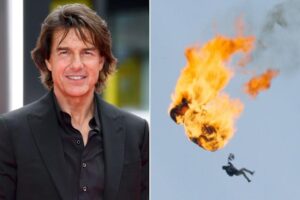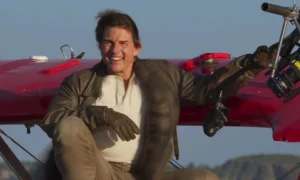SAD NEWS: American actor Tom Cruise is said to have had a serious @ccident while filming an aerial scene for the movie “Mission: Impossible”, only 15 minutes later the entire film crew had to stop all activities and announced that he had

A renowned Hollywood star, Tom Cruise, reportedly sustained a serious accident while filming an aerial scene for the latest installment in the “Mission: Impossible” franchise.
The shocking incident occurred during a high-altitude sequence involving the actor performing his own stunts, which is known to be his signature approach to action filmmaking. News of the accident quickly rippled through the set, causing production to halt within fifteen minutes. The entire film crew, prioritising safety, ceased all activities immediately and awaited official confirmation of the actor’s condition.
Witnesses on set described a tense atmosphere as crew members scrambled to secure equipment and assist medics rushing to the site. Despite the swift medical response, details of the actor’s injuries remain scarce. Initial reports suggest that the injury may be significant, potentially involving either a fall from a vehicle or impact during a helicopter manoeuvre—elements typically featured in high-risk aerial stunts. Speculation continues to circulate, with some sources citing a “serious accident” but declining to elaborate further pending a full investigation. The prudence exercised by suspending production so quickly underscores both the severity of the incident and the production’s adherence to safety protocols.

Fans and industry professionals have expressed mounting concern for the star’s wellbeing. On social media platforms, messages of support poured in, with admirers wishing for a swift recovery and applauding Cruise’s dedication to performing his own stunts. Industry colleagues echoed these sentiments, underlining the actor’s reputation for pushing physical boundaries and raising the stakes in action cinema. At the same time, discussions emerged surrounding on-set safety standards, especially given the frequent use of practical effects and real stunts in the “Mission: Impossible” series. This incident reignites longstanding debates about balancing realism with safety, and whether certain stunts should be reimagined or modified.
Taken seriously by the studio and production team, the incident triggered a formal safety audit.
Representatives from the film’s production company initiated an immediate review of all aerial sequences and supporting protocols. Key personnel, including stunt coordinators, safety officers, and medical teams, convened to reassess procedures. The review aims to determine whether any missteps occurred in planning, technical setup, or execution. In parallel, the film’s insurance providers are reportedly monitoring developments closely. Insurance coverage for high-risk stunts often carries stringent conditions, and the nature of Cruise’s known involvement in such sequences could invite scrutiny regarding regulatory compliance and liability.
Despite the alarm, the overall tone from sources close to the production suggests cautious optimism. While the exact extent of the actor’s injuries remains undisclosed, insiders describe his condition as stabilising, with no immediate life-threatening concerns. The medical team is said to be conducting further assessments to evaluate the recovery timeline. In the meantime, no official statement has been released by the film studio, Cruise’s representation, or the production publicist. The creation of a controlled communication strategy is underway, with expectations that a public announcement may follow once more information is verified.

Beyond the immediate priorities of health and safety, the incident poses broader implications for the film’s schedule and budget.
A production shutdown, even temporary, can result in substantial cost overruns and logistical disruption. Crew call-sheets, location bookings, equipment rentals, and travel arrangements may all be affected. However, the producers seem determined to safeguard both assets and personnel. Contingency plans, such as insurance claims, rescheduling, and adapting the shooting schedule, are likely being enacted. Should the actor require extended medical leave, postponement of remaining aerial sequences or recasting for specific minor stunt components might be considered, although Cruise’s commitment to performing his own stunts suggests alternatives will be carefully evaluated.
Interestingly, this event shines a spotlight on the broader cultural fascination with Tom Cruise’s personal involvement in physically demanding scenes. Over the years, Cruise has built a reputation for performing death-defying stunts—from hanging off real airplanes to scaling skyscrapers—making each new “Mission: Impossible” entry a headline generator in its own right. Admirers laud his athleticism, fearlessness, and commitment to authenticity, while critics caution against the inherent dangers. This latest incident may prompt the industry to reexamine risk-management frameworks and explore innovations such as advanced visual effects, enhanced rigging systems, or drone-assisted shots that could reduce real-world hazard without diminishing spectacle.
Industry analysts emphasise that this moment may mark a turning point in how big-budget action films approach safety. With production protocols under scrutiny, studios might implement more rigorous pre-shoot safety drills, mandate external safety audits regulated by third parties, or deploy new cutting-edge monitoring technologies on set. In this context, Cruise’s involvement takes on even greater significance: as an actor-producer figure with high creative control, his choices could influence emerging standards across the industry. A measured and transparent approach to the incident’s resolution could set a positive precedent, reassuring both cast and crew in future high-stakes productions.
While fans await updates regarding Tom Cruise’s health, the broader cinematic world anticipates how this episode will shape the remainder of the “Mission: Impossible” shoot. If the actor recovers swiftly, production may resume with renewed emphasis on safety and communication. Alternatively, a longer recovery could necessitate creative workarounds or temporary shifts in focus to other storylines or characters. Regardless, the incident serves as a stark reminder of the fine line between cinematic spectacle and real-world peril—a balance that filmmakers must tread with care, especially when their leading man consistently raises the bar for on-screen authenticity.
In summary, reports indicate that American actor Tom Cruise experienced a serious accident while performing an aerial stunt for the new “Mission: Impossible” film, prompting an immediate halt to production within a quarter-hour. Emergency response teams were activated, and the actor’s status is described as stabilising, though details remain scarce. A thorough safety review and insurance evaluation are underway, and the industry is closely watching how the incident might prompt changes to stunt protocols and safety standards. Fans remain hopeful, production logistics are being reassessed, and the outcome could redefine the way extreme action sequences are executed in the future.
